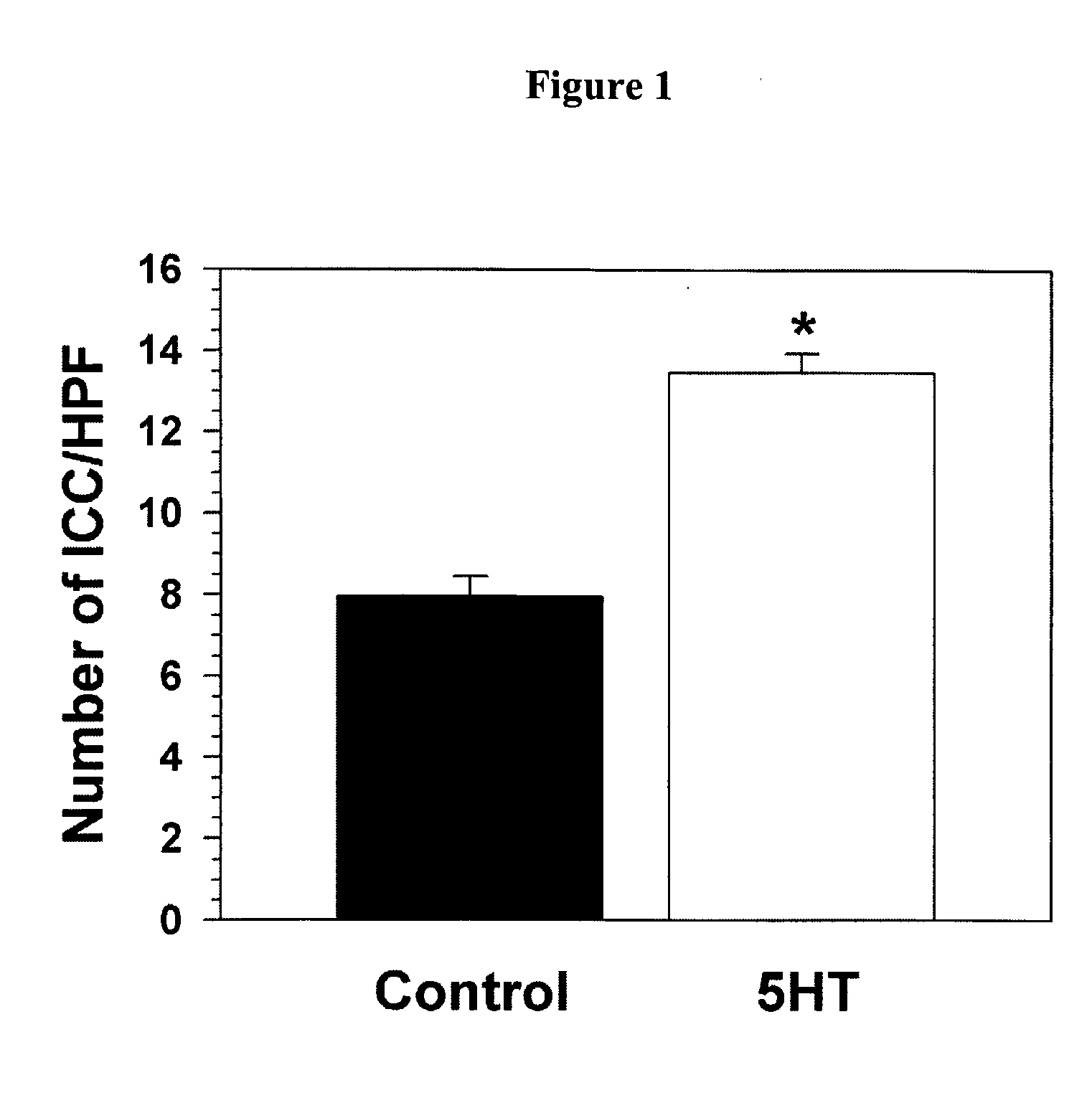Treating Digestive Tract Conditions
a digestive tract and treatment method technology, applied in the field of digestive tract treatment methods and materials, can solve the problems of abdominal distention, nausea, vomiting, abdominal distention, etc., and achieve the effects of reducing the number of patients, and improving the quality of li
- Summary
- Abstract
- Description
- Claims
- Application Information
AI Technical Summary
Benefits of technology
Problems solved by technology
Method used
Image
Examples
example 1
Serotonin Increases the Number of ICC
[0039]An ICC culture technique was developed and used to test whether 5HT increases ICC number in culture. Mouse intestinal tissue was dissociated, and ICC placed in culture over fibroblasts engineered to make Steel factor (Rich et al., Am. J. Phys. Gastro. Liver Physiol., 284(2):G313-20 (2003)). Blinded parallel cultures were established (n=2, 6 day old Balb / C mice yielding 6 coverslips). 5HT (1 μM) was added to half of the coverslips every 12 hours for 24 hours, after which the cells were fixed. ICC were identified using an antibody to c-kit and counted. Mast cells, which were identified by their characteristic size and round shape, were not included in the analysis. 5HT markedly increased the number of ICC from 8±0.5 ICC per HPF to 14±0.4 ICC per HPF (P<0.0004; FIG. 1). These results demonstrate that 5HT markedly increases the number of ICC.
[0040]To determine if the effects of 5HT on increasing the number of ICC were mediated through the 5HT2B...
example 2
Treatment of Digestive Tract Conditions with 5HT and 5HT2B Receptor Agonists
[0049]W / WV mice lack certain classes of ICC, and the stomach and small intestine in W / WV mice do not contract well with delayed movement of food through the stomach and intestine. W / WV mice can be used as a model for gastroparesis, intestinal pseudo-obstruction, and constipation.
[0050]W / WV mice are sterile. Thus, W mice are bred with WV mice to obtain W / WV mice. Pregnant heterozygote mice are fed a 5HT2B receptor agonist such as m-chlorophenylpiperazine (0.5 mg / kg) or α-methyl-5-hydroxytryptamine maleate (500 nM) starting 2 weeks before birth. The pups are fed the agonist three times a day for an additional 1 to 3 weeks. At 1 to 3 weeks post partum, gastric emptying and the volume of ICC in the stomach and intestine of pups treated with the 5HT2B agonist are compare to the gastric emptying and the volume of ICC in the stomach and intestine observed with control untreated pups.
[0051]Gastric emptying is measur...
example 3
Serotonin Increases the Number of ICC from Adults
[0060]To determine the effects 5HT has on cells from adult mice, an organotypic culture was used. Briefly, one cm segments of mouse small intestine were cut, pinned flat mucosa side up, stripped of mucosa and submucosa layers, and placed into fresh, sterile-filtered Kreb's solution with 3 mM antibiotic. Krebs was removed, and DMEM (Dulbecco's Modified Eagle's Media) with 10% FBS (Fetal Bovine Serum) and 1% antibiotic / antimycotic was added to the culture. Explants from 6 month old mice were incubated at 37° C., 5% CO2.5HT (1 μM) was added in fresh medium twice daily. In the control explant, medium was added without 5HT. The tissue was fixed at day 8 and stained using an antibody to c-Kit. Images were collected using a confocal microscope and reconstructed in 3D, and the volume of ICC calculated. The stack of confocal images revealed the preservation of ICC networks in the organotypic culture at day 8 and the greater number of ICC in th...
PUM
| Property | Measurement | Unit |
|---|---|---|
| surface area | aaaaa | aaaaa |
| size | aaaaa | aaaaa |
| thickness | aaaaa | aaaaa |
Abstract
Description
Claims
Application Information
 Login to View More
Login to View More - R&D
- Intellectual Property
- Life Sciences
- Materials
- Tech Scout
- Unparalleled Data Quality
- Higher Quality Content
- 60% Fewer Hallucinations
Browse by: Latest US Patents, China's latest patents, Technical Efficacy Thesaurus, Application Domain, Technology Topic, Popular Technical Reports.
© 2025 PatSnap. All rights reserved.Legal|Privacy policy|Modern Slavery Act Transparency Statement|Sitemap|About US| Contact US: help@patsnap.com



